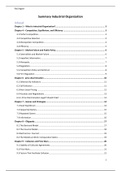Samenvatting
Summary Introduction to Industrial Organization
- Instelling
- Wageningen University (WUR)
This is a summary of all the required reading, that I thought was most relevant, from the book ''Introduction to Industrial Organization''
[Meer zien]






